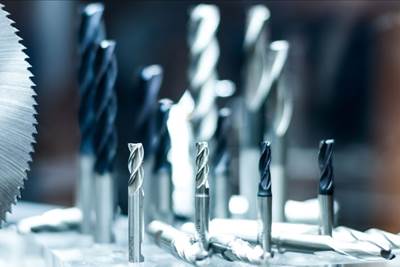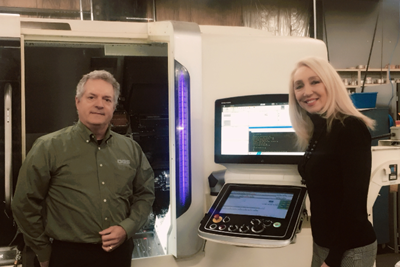Building Out a Foundation for Student Machinists
Autodesk and Haas have teamed up to produce an introductory course for students that covers the basics of CAD, CAM and CNC while providing them with a portfolio part.
Share


Hwacheon Machinery America, Inc.
Featured Content
View More
.png;maxWidth=45)
DMG MORI - Cincinnati
Featured Content
View More
Takumi USA
Featured Content
View More



Autodesk, Inc.
Featured Content
View More

Reshoring manufacturing requires a domestic talent pool, one trained in modern manufacturing technology and ready for the challenges of today’s parts. The race to build this talent pool has led vocational schools, tech programs and other manufacturing instructors to source curricula that can slot into their classrooms while staying relevant to students’ needs and interests, all while providing a usable portfolio of parts. Recognizing the need for usable curricula, Autodesk and Haas jointly developed a semester-long curriculum that the companies debuted in May 2024. This curriculum acts as survey, resume-builder and certification-preparation all in one, creating a foundation for students to learn the manufacturing craft.

Ed Doherty, industrial lab assistant and instructor at Suncoast Technical College, says the pilot version of the curriculum proved to be an efficient way to teach the basics of milling. “When students using this curriculum came out onto the shop floor, they were further ahead than any other student I ever had,” he says. Images courtesy of Autodesk.
Plug-and-Play Learning
Autodesk Technology Communication Manager Jason Love says that the company has long fielded requests from educators for “plug-and-play” project-based content that is pre-validated and does not require tweaks for classroom use. Curt Chan, Autodesk’s strategic partnerships manager taking point on the project, says that the company thought the best way to go about creating this content was to partner with Haas, given its experience working with educational programming and its existing audience of over 8,500 machines in educational environments across the U.S. and Canada.
The curriculum that the two companies created teaches 2.5-axis milling through four courses in Autodesk Fusion. Completing the curriculum and passing a final test earns students a certificate of completion. It also puts students on a path to achieving an “Autodesk Certified Associate in CAM for 2.5-Axis Milling” certification — Chan says it takes them about 80% of the way to certification readiness. He says students can then follow the curriculum with a test-prep class and be fully ready to take the certification exam.
CAD, CAM, CNC and Beyond
Autodesk and Haas developed the curriculum over two years. It reflects the types of skills its creators saw commonly appear in job postings while also considering feedback from vocational instructors. Each of the four courses assumes the use of a Haas mill in conjunction with Autodesk Fusion, using the combination to teach students the foundational blocks of both design and milling. Chan says that this combination is especially important as it enforces the idea of designing for manufacturability — in his previous career as a manufacturing instructor, he says a common error students made was designing difficult-to-mill features like square pockets with no fill.
The first courses starts with instruction on how to read a blueprint and interpret GD&T symbols, then continues through best practices on machine safety, how to create CAM setups, how to set up and run a VMC, and basic inspection. Later courses expand into basic CAD design and tool library creation, NC program and tool path creation, soft jaw creation and machining, creation of finishing toolpaths, program simulation, documentation creation and in-machine probing. As part of this, students design and machine a brake caliper assembly, which they can then include in a portfolio for their job search.
Chan estimates that covering the four courses should require a full semester of in-classroom instruction, but that quarterly programs or those with limited numbers of milling machines could do the courses for the software online, with the CNC machining portions in-person. As he puts it, time on the machine is the most important aspect of the curriculum, but it is also one of the most difficult to guarantee with schools’ varying numbers of students and machines.

The Autodesk and Haas teams wanted the part produced during the curriculum to be something relevant to students’ interests. With many technical and vocational schools sponsoring student racing teams, Chan and his coworkers decided upon brake calipers to capitalize on this interest.
The Road Ahead
Autodesk and Haas took the curriculum to several vocational schools for a six-month pilot program, iterating on it to meet the feedback from the instructors. For example, Chan says that a common early request was for quizzes and other ways of testing student knowledge before they do work involving machine tools. The companies then developed quizzes, and continue to update the courses with additional assessment activities. Similarly, at the request of schools with a quarterly schedule, the companies reexamined the length of the lessons in the program to tighten them in service of a shorter schedule.
In the future, Chan hopes to add more inspection content for schools that are able to afford advanced metrology equipment. The companies also plan to develop a turning-centered version of the program in response to strong demand from instructors. Building out this curriculum will take time, Chan says, so that he and the rest of the team can ensure it meets the same standards they targeted for the milling program: simple-to-use, well-rounded and tied to well-regarded certifications. This last point is perhaps the most important, he continues, as certifications are a primary way that students can prove they have experience with particular skills, software and machines.
With the current milling curriculum putting students on the path to certifications from both Autodesk and Haas, future curricula have a goal to strive toward just as much as the students.
Related Content
Same Headcount, Double the Sales: Successful Job Shop Automation
Doubling sales requires more than just robots. Pro Products’ staff works in tandem with robots, performing inspection and other value-added activities.
Read MoreWorkholding Fixtures Save Over 4,500 Hours of Labor Annually
All World Machinery Supply designs each fixture to minimize the number of operations, resulting in reduced handling and idle spindle time.
Read MoreIn Moldmaking, Mantle Process Addresses Lead Time and Talent Pool
A new process delivered through what looks like a standard machining center promises to streamline machining of injection mold cores and cavities and even answer the declining availability of toolmakers.
Read MoreCan Connecting ERP to Machine Tool Monitoring Address the Workforce Challenge?
It can if RFID tags are added. Here is how this startup sees a local Internet of Things aiding CNC machine shops.
Read MoreRead Next
Addressing the Manufacturing Labor Shortage Needs to Start Here
Student-run businesses focused on technical training for the trades are taking root across the U.S. Can we — should we — leverage their regional successes into a nationwide platform?
Read MoreBack to School: CNC School Co-Locates With Machine Shop
By allowing this CNC school to operate inside its facility, this machine shop benefits as much as the school does.
Read MoreThe Power of Practical Demonstrations and Projects
Practical work has served Bridgerland Technical College both in preparing its current students for manufacturing jobs and in appealing to new generations of potential machinists.
Read More

































.jpg;maxWidth=300;quality=90)








